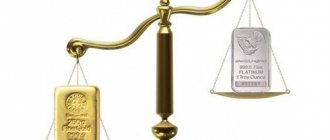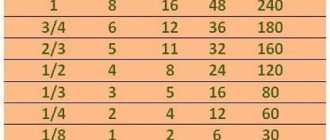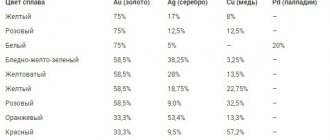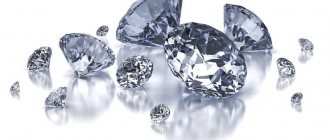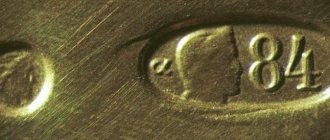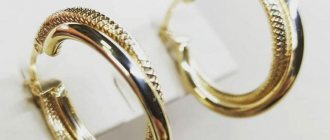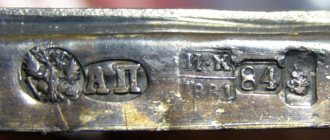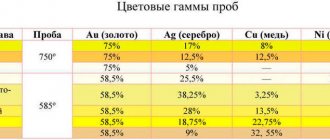►
watch video
►
read educational program for investors
►
buy investment gold
So, an ounce used by banks and jewelers is a measure of weight equal to 31.1034768 grams, which corresponds to 480 grains (a pharmaceutical unit of measurement) or 1/12 of a troy pound (not to be confused with the traditional British pound). The troy ounce also has its official international designation - “oz t”.
Brief historical excursion
In ancient times and the Middle Ages, the main unit of mass measurement was the pound. In many countries it corresponded to different weights. So, in Russia it was 0.41, in Britain - 0.35, and in Ancient Rome - 0.32745 kilograms.
One twelfth of every pound was called an ounce. They calculated not only mass, but also area, length, and volume. Many of these units of measurement still exist today. An example is the American and English fluid ounce (“fl oz”), which is approximately 30 milliliters, and the so-called avoirdupois ounce (“oz at”), which is approximately 28 grams.
By the 14th century, the history of the famous fair in the city of Troyes (the historical capital of the French province of Champagne) already spanned more than 9 centuries. It was here that a special Troy pound appeared, named after the city. It was used to measure the weight of goods such as medicines, cosmetics, spices, grains, etc.
Thus, the province of Champagne is famous not only for its medieval architectural monuments, sparkling wines and gastronomic delights, but also for its special pound. In the 20th century, it became the basis for one of the main units of measurement of the mass of precious metals.
This is interesting.
Until now, in literature or historical chronicles, the word “ounce” can be understood as 1 Chinese tael, 3 Sicilian ducats, 1 South American doubloon, 1/16 of a Portuguese or Spanish trade pound, 1/12 of an Italian pound or 1/8 of a German mark.
But only an ounce, equal to 31.1034768 grams, is a universal international unit of measure for the weight of gold, silver and other precious metals, as well as products and coins made from them.
Ounces to Kilograms Calculator
You convert ounces to kilograms
Calculator - Weight and Mass - Ounces to Kilograms
How many kilograms in ounces - convert oz to kg
1 Ounce (oz) = 0.02 Kilograms (kg)
Ounces An ounce (abbreviation: "oz") is a unit of mass that has several definitions. Often an ounce is equal to 28 grams. Its size may vary in different systems. Today, the most widely used international ounces are avoirdupois, equal to 28.3495231 grams, and troy ounces, equal to 31.1034768 grams.
Kilograms The kilogram (symbol: “kg”), also known as kilo, is the basic measurement of mass in the International System of Units. Defined as a measure equal to the mass of the International Prototype Kilogram (IPK), it is related to the mass of almost one liter of water. It is the only basic unit of measurement that uses the prefix (“kilo”, symbol: “k”) as part of its name. The kilogram is very stable, which is really important, since 4 of the 7 basic units of the international system are directly related to the kilogram.
Conversion of units of Weight and Mass
Convert from
Convert to
oz
=
kg
| Basic units of weight | |
| Carat | car |
| Gram | gr |
| Kilogram | kg |
| Milligram | mg |
| Ounce | oz |
| Lb | lb |
| Ton | T |
| Other units of mass | |
| Assarion | assarion |
| Atomic mass unit (Dalton) | A. eat. |
| Attogram | ag |
| Bekah | |
| Centigram | cg |
| Dalton | |
| Dg | dg |
| Dekagram | dag |
| Denarius | denarius |
| Didrachm | didrachma |
| Drachma | drachma |
| Dina | dyn |
| Exagram | Eg |
| Femtogram | fg |
| Hera | gerah |
| Gigagram | Gg |
| Grain | gr |
| Hectogram | hg |
| Hundredweight | cwt |
| Hundredweight(UK) | cwt |
| Kip | |
| Mite | lepton |
| Megagram | Mg |
| Microgram | µg |
| Mine | mina |
| Mina(Biblical Hebrew) | mina |
| Nanogram | ng |
| Pennyweight | pwt |
| Petagram | Pg |
| Picagram | pg |
| Poundal | pdl |
| Quadrant | quadrans |
| Quarter | |
| Quarter(UK) | quarter |
| Quintal | quint. |
| Scruple | scr |
| Shekel | shekel |
| Slug | |
| Stone | st |
| Stone(UK) | st |
| Talent(Greek) | |
| Talent(Hebrew) | |
| Teragram | Tg |
| Tetradrachm | tetradrachma |
| Ton | |
| English ton | |
| Troy ounce | |
| Pharmacist's pound | |
| Basic units of weight | |
| Carat | car |
| Gram | gr |
| Kilogram | kg |
| Milligram | mg |
| Ounce | oz |
| Lb | lb |
| Ton | T |
| Other units of mass | |
| Assarion | assarion |
| Atomic mass unit (Dalton) | A. eat. |
| Attogram | ag |
| Bekah | |
| Centigram | cg |
| Dalton | |
| Dg | dg |
| Dekagram | dag |
| Denarius | denarius |
| Didrachm | didrachma |
| Drachma | drachma |
| Dina | dyn |
| Exagram | Eg |
| Femtogram | fg |
| Hera | gerah |
| Gigagram | Gg |
| Grain | gr |
| Hectogram | hg |
| Hundredweight | cwt |
| Hundredweight(UK) | cwt |
| Kip | |
| Mite | lepton |
| Megagram | Mg |
| Microgram | µg |
| Mine | mina |
| Mina(Biblical Hebrew) | mina |
| Nanogram | ng |
| Pennyweight | pwt |
| Petagram | Pg |
| Picagram | pg |
| Poundal | pdl |
| Quadrant | quadrans |
| Quarter | |
| Quarter(UK) | quarter |
| Quintal | quint. |
| Scruple | scr |
| Shekel | shekel |
| Slug | |
| Stone | st |
| Stone(UK) | st |
| Talent(Greek) | |
| Talent(Hebrew) | |
| Teragram | Tg |
| Tetradrachm | tetradrachma |
| Ton | |
| English ton | |
| Troy ounce | |
| Pharmacist's pound | |
Conversion result:
Other popular mass and weight calculators
- Carat to Gram
- Carat to Kilogram
- Carat to Milligram
- Carats to Ounces
- Carat to Pound
- Carats to Tons
- Gram to Carat
- Gram to Kilogram
- Gram to Milligram
- Gram to Ounce
- Gram to Pound
- Grams to Tons
- Kilogram to Carats
- Kilograms to Grams
- Kilogram to Milligram
- Kilograms to Ounces
- Kilogram to Pounds
- Kilogram to Tons
- Milligram to Carat
- Milligram to Gram
- Milligram to Kilogram
- Milligram to Ounce
- Milligrams to Pounds
- Milligrams to Tons
- Ounce to Carats
- Ounce to Gram
- Ounce to Kilogram
- Ounce to Milligram
- Ounce to Pound
- Ounce to Ton
- Pound to Carat
- Pound to Gram
- Pound to Kilogram
- Pound to Milligram
- Pound to Ounce
- Pound to Tons
- Ton to Grams
- Ton to Kilos
- Ton to Milligrams
- Ton to Ounces
- Ton to Pounds
Modern use of this unit of measurement
Today, all trading operations with gold and silver in the international precious metals market are carried out on the basis of the troy ounce, as the only accepted measure of weight. In the display of stock quotes, it is indicated in a special way:
- for silver - XAG;
- for gold - XAU;
- for palladium - XPD;
- for platinum - XPT.
When issuing coins made of gold, silver and other precious metals, foreign central banks also measure their weight in fractional parts of an ounce.
This is not accepted in Russia, and the mass of coins issued by the Central Bank is calculated in grams. But it often happens that mass still forms some part of the universal unit of measurement. Thus, St. George the Victorious with a nominal value of 50 rubles contains 7.78 grams of gold, which corresponds to a quarter of a troy ounce. And the same silver coin with a nominal value of 3 rubles is made from 1 troy ounce.
Varieties of ounces
Before converting one value to another, decide which ounce you are interested in. Ounce is abbreviated as oz. If you see this sign, be aware that you will need to convert ounces to grams to understand the weight of the item. Next to this value, another letter is assigned, depending on the type of ounce. There are several types:
- Troy ounce. Its value is 31.1034 grams. It is by far the most popular, since it is in it that the weight of gold is measured. This process takes place on the precious metals exchange in London. There, the measure of weight is the troy ounce, which, as a guarantor of stability, has accompanied gold for several centuries. A fluid ounce is not a troy ounce. The name originated in the town of Troyes, where fairs were held. Buyers and sellers could not agree and determine the value of coins or bullion bars. Therefore, money began to be equalized by weight. Therefore, this standard is nothing more than following traditions. They even issued several coins that weigh exactly the same as a troy ounce.
- An avoirdupois ounce, or trade ounce, corresponds to 28.35 grams. This is a type of trade ounce that was previously used even in the sale of groceries. Nowadays weight is measured in pounds. This is popular in the USA and England. One pound is the same weight as 16 ounces.
- A pharmaceutical ounce corresponds to approximately thirty grams of the substance.
How to convert a troy ounce into the usual grams of gold or silver?
The mass of a troy or gold coin pound is 373.2417 grams.
1/12 of it or 31.1034768 grams is a troy ounce.
This value is too precise. In practice, they use its abbreviated version 31.1035. Thus, 1 kilogram of gold or silver contains 32.1507 troy ounces of the precious metal.
To convert this international value into grams, it is enough to multiply the weight value represented in it by 31.1035. The reverse conversion to ounces is carried out by dividing the mass value by the same number.
To make calculations easier on the Internet, there are many special online converters that will quickly and easily perform all the calculations for you.
Exchange rate oz (ounce)
So, in the 21st century, the price of gold is still linked, as in Ancient Rome and medieval Europe, to an ounce. But of the many types of this weight measure, only the troy one is now used. So in everyday speech, for the sake of brevity, we often just talk about the price of an ounce of gold.
What is the cost of an ounce of gold? This value is variable and changing. The price of a troy ounce of gold depends on the exchange rate, which is constantly changing. The price of gold per ounce is formed using the London fixing operation. According to tradition, twice a day, at 10.30 and 15.00, the new value of this precious metal is fixed.
The gold rate in oz can be found in three modern currencies: the American dollar, the British pound and the euro. However, in exchange practice the US dollar is mainly used. Most often, when people ask how much an ounce of gold currently costs, the price is quoted in American currency.
How much a troy ounce of gold costs is determined by the five leading banks on the planet, analyzing the demand for the precious metal on the world market and the corresponding supply. Participating in the London fixing are Deutsche Bank, HSBC, Société Générale, Scotia Mocatta and Barclays Capital.
At the moment, stock exchange trends show an increase in gold prices. According to expert forecasts, this trend will continue for about five more years.
How much does a troy ounce of silver or gold cost?
In the period from 1919 to 2015, with the exception of the Second World War, the price of gold or silver was determined by the international interbank exchange in London, assigning the so-called “London fixing”. Since 2015, this system has been changed. Now, every day twice, at 10-30 and 15-00 GMT, a new price for precious metals is announced based on the ongoing electronic auctions.
Previously, only 5 main companies producing and selling precious metal bullions took part in determining the value of gold and silver. Currently, there are about 13 banking organizations from countries such as Switzerland, France, Canada, the United States of America, China and the Republic of South Africa. The Russian Federation is not included in this list.
The price of the precious metal fluctuates daily. Therefore, in order to navigate market dynamics and build the right investment strategy, it is necessary to constantly monitor the information available on the Internet.
To summarize what has been written, we can say that now you probably understand why the cost of an ounce of precious metals such as gold or silver is exactly 31.1035 times more than the cost of one gram, and also why the ounce itself is called “troy”.
History of the Troy Standard
The use of the ounce as a measure of weight began in the era of Ancient Rome. It was one twelfth of the libra. How many grams were there in an ounce at that time? Historians have found the answer to this question: 327.45 grams. (Therefore, an ounce of gold today has about 4 grams more than that of ancient Rome). The ancient Romans divided this measure of weight into 2 semuntions. There were also smaller weight measures:
- semuntia – ½ oz;
- sicilicus – 1/4;
- sextool – 1/6;
- scruple – 1/24;
- silicva – 1/144.
Why did it happen that an ounce of gold today does not correspond in weight to that of ancient Rome? To answer this question, you need to dive into the Middle Ages, when not only each country, but also many duchies and counties issued their own coins. It is even difficult for a modern person to imagine how difficult it was for medieval financiers - money changers!
When merchants from different countries and provinces came to a large fair, each brought their own money, which varied in weight and gold content. Counterfeiters often tried to sell money at fairs, and it also happened that feudal lords (even kings!) deliberately reduced the gold and silver content of coins. In addition, in the Middle Ages, people for a long time used old coins that were several centuries old - including those of states that had already disappeared, because gold remained gold. True, the weight of such coins gradually decreased - after all, they were worn out. And some cunning people even cut coins from precious metals.
Money changers - future bankers - solved this confusion by weighing coins and determining the purity of the precious metal. It was they who introduced the unified Troy standard into use.
One of the largest fairs in the Middle Ages took place in the French province of Champagne, where famous wines were produced, as now. The fair in the city of Troyes was large, international, and authoritative. It was here in the 12th–14th centuries that money changers used the ounce as a standard, which weighed the same 31.1035 grams when converted to the modern metric system. This is how ounce from Troyes became the most authoritative measure in the financial environment. And now, when they ask how much an ounce of gold weighs - how many grams are in it, they mean exactly the troy standard.
In those days, this measure of weight was also used to measure other goods, such as grain. Subsequently, this measure became entrenched in the financial environment and the jewelry business. The popularity of the ounce turned out to be so great that many gold mints relied on it. For example, Spanish doubloons are the same ounces of gold. The English gold mint extended this standard to many countries that were previously colonies of the British Empire: this is how much, for example, American “eagles” and “buffalos”, “maple leaves” of Canada, and Australian gold bars weigh.
It is sometimes mistakenly believed that the name of the troy ounce comes from the city of Troy. This is not so: the name is given after the city of Troyes - Troyes.
Where does the name of the unit of measurement come from?
The name of the troy ounce presumably comes from the French city of Troyes, a center of international trade known since the 9th century. The first mention of the troy ounce dates back to 1390. In Troyes, which at that time was one of the most important centers of trade in the world, a standard system of measures was introduced to simplify the exchange of goods between traders from different countries. The basis for the standardized measure of weight was the French livre, which included the troy pound of silver. Soon, by order of the English king with French roots, Henry II , troy units of measurement - grains, ounces and pounds - began to be used in England.
These weights were also used to weigh grain crops. In addition, the troy ounce was used by pharmacists at that time to determine the weight of drugs.
The previously existing Troyes system of measures is now outdated; troy ounces are actively used only in banking and jewelry as a noble standard for the weight of precious metals.
What else is measured in troy ounces?
The weight of precious metal coins issued by central banks is measured in fractions of a troy ounce. For example, in the United States, American Eagles have been minted since 1986 - an official means of payment recognized in the world precious metals market. The coins are available in four denominations: 1/10, 1/4, 1/2 and 1 ounce. Based on the Gold Weight Coin Act, the gold content of the coins is guaranteed by the US government. Thus, a gold coin weighing 1 ounce, i.e. 31.104 grams, weighs a total of 33.931 grams. It has a diameter of 32.70 millimeters and a thickness of 2.87 millimeters.
Most modern coins are produced from various alloys that contain one or another proportion of precious metal. In Russia, grams are usually used to indicate the weight of a coin, but the precious metal content always corresponds to a certain fraction of a troy ounce. Thus, the gold commemorative coin “St. George the Victorious” with a face value of 50 rubles, issued by the Bank of Russia, weighs 7.89 grams, the mass of pure gold in it is at least 7.78 grams, which is 1/4 troy ounce. And the silver “St. George the Victorious” with a face value of 3 rubles weighs 31.5 grams, the mass of pure silver in the coin is at least 31.1 grams, i.e. approximately one troy ounce.
How many grams of different products fit in a faceted glass. Memo Read more
